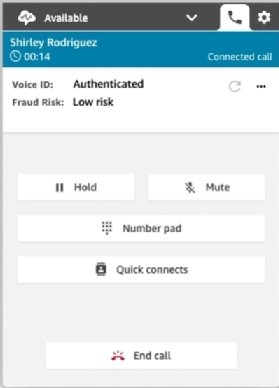
Getty Images
Amazon Connect adds voice ID, agent assist features
AWS adds tools to search knowledge bases for answers based on terms picked up via in-call voice recognition, as well as voice ID to confirm identities of callers.
Amazon Connect continues its advance into the contact center as a service market by adding two data-intensive features that tap into AWS's cloud infrastructure: Amazon Connect Voice ID and Amazon Connect Wisdom, an agent-assist tool.
Both features are available today. Another feature that manages high-volume outbound calls, texts and emails is in preview.
Amazon Connect's big advantage over contact center as a service (CCaaS) competitors, said Opus Research founder Dan Miller, is its built-in prospective customer base of AWS users -- for whom integration issues are lessened, as Amazon Connect is native to that cloud.
"They want to target companies that are already using AWS in some way, shape or form, and have the sales people knock on the door and say 'Hey, did you know by hitting this radio button on your AWS developer console, you can activate a full-fledged contact center?'"
'Wisdom' surfaces potential answers
Amazon Connect Wisdom surfaces information that might solve a caller's issue, when used in conjunction with Contact Lens, the AWS service that transcribes and analyzes incoming calls with natural language processing AI. Amazon Connect Wisdom also avails a search field to agents for use when the right information doesn't display.

The tool connects to existing knowledge bases or can assemble content into its own repository, said Pasquale DeMaio, general manager of Amazon Connect at AWS. Amazon Connect has integrations with customer experience platforms such as Salesforce and ServiceNow, the two most commonly integrated agent desktops.
Medium-size businesses lean toward an integrated Amazon Connect stack, DeMaio said, while larger customers often use platforms like Salesforce -- or have built their own agent desktops -- and will integrate tools like Wisdom into those existing applications.
AWS claims that Amazon Connect users conduct 10 million customer interactions per day. Miller said Amazon Connect has evolved from a bare-bones services when it was released in 2017 to packages that are easier to set up. One example of this is Contact Lens, which in addition to performing call analytics also redacts customer information protected by regulation -- an essential need for contact centers.
This and aggressive pay-as-you-go pricing that scales up during busy times such as holidays, has made Amazon Connect a formidable CCaaS competitor.
"There isn't as much of a construction project as there used to be," Miller said. "What we're seeing now is sort of the older and wiser Amazon Connect, in terms of packaging and pricing."
Miller added, though, that an Amazon takeover of the CCaaS market is unlikely, at least in the near term. The CCaaS landscape is growing, he said, potentially to a $100 billion total annual revenue size, and there are so many competitors -- and so many contact centers that have invested in non-AWS applications and hardware -- that the mixed-vendor stack will be around for some time to come. CCaaS vendors who build the frameworks that accommodate customers mixing different features and services from a multitude of companies will be the winners, he said.
Voice biometrics appeal to financial verticals
Amazon Connect Voice ID creates voiceprints from ongoing conversations, as opposed to systems that prompt a user to speak short sample phrases and records them. That was by design, DeMaio said, because the developer's intention was to make the process natural and comfortable for both the users of the technologies and callers to the contact centers.
"Essentially, everything we build at Amazon is based on customer asks -- almost all of it, 95%-plus," DeMaio said. "Customers who wanted to do voice biometrics said they wanted to authenticate users, but [the technology is] painful, they didn't know if it works, but they were interested in it, though. We said, 'OK, let's see how we can make this simpler.'"

At the moment, both Miller and DeMaio said, voice biometrics have more utility in regulated industries such as financial services, where a common use case is preventing fraud committed against seniors, often at the hands of younger relatives. But while it's still largely theoretical now, voice authentication tools could also be used for both security and convenience to prevent customers from having to repeat their information between written channels such as text and chat to calls.
AWS also plans to add high-volume outbound communications tools for phone and written channels, now in preview. It can launch outbound campaigns on multiple channels to contact lists, throttle communications according to agent availability, and autodial calls and route them so agents only take live calls with customers waiting.
Healthcare users will likely be early adopters of this feature, DeMaio said, as they often have large numbers of outbound followups for patients with whom they have existing relationships.
Don Fluckinger covers enterprise content management, CRM, marketing automation, e-commerce, customer service and enabling technologies for TechTarget.







